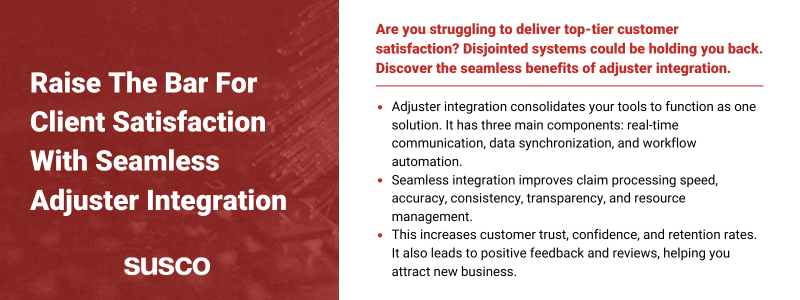Are you struggling to deliver top-tier customer satisfaction? Disjointed systems could be holding you back. Discover the seamless benefits of adjuster integration.

Benjamin Franklin certainly hadn’t envisioned insurance adjusting (IA) in the 21st century when he remarked that only death and taxes are certain in life. Let us explain.
Digital transformation has pushed IA firms into new territory. Efficiency, productivity, and client satisfaction now require a custom claims management system (CMS), workforce mobile app, web portal, customer relationship management (CRM) system, and other digital tools.
While a growing IT ecosystem offers significant improvements, it can lead to challenges like inefficient workflows, redundant processes, and siloed data if not properly integrated. Enhancing system connectivity is becoming increasingly important to maintain competitiveness.
As a result, there’s one more thing IA firms can be sure about—adjuster integration.
In this article, we cover everything you should know about adjuster integration. You’ll learn about its essential components and impact on operations and customer satisfaction. Let’s jump in.
Adjuster integration explained
Adjuster integration leverages various technologies, including application programming interfaces (APIs), custom-coded solutions, and middleware, to build seamless links and data flow across separate platforms, apps, and systems.
Here, your tools function as a single coordinated solution and communicate without manual intervention. This streamlines the claims process, enhancing efficiency and accuracy.
The critical components of seamless adjuster integration include:
- Real-time communication: Solutions are always on and connected. They talk with each other instantly, keeping everyone in the loop without delay.
- Data synchronization: Information is continuously updated and harmonized to maintain consistency across all platforms.
- Workflow automation: Mundane and repetitive tasks like data entry are automated, allowing adjusters to focus on what matters—resolving claims.
Adjuster integration ties everything together, making the claims process faster, more accurate, and less stressful for everyone involved.
Benefits of seamless adjuster integration
IA firms reap these seamless benefits from system integration:
- Faster claim processing: Consolidation speeds up claims processes across the board, reducing resolution time. For instance, connecting internal systems and estimation platforms allows seamless transmission of first notice of loss (FNOL) data and automation of claim assignment creation, leading to faster assessments and approvals.
- Improved accuracy and consistency: Data synchronization eliminates manual data entry across platforms, saving time and improving accuracy. When adjusters update claim details in one system, those changes automatically reflect across all connected systems, ensuring everyone is working with the same information.
- Enhanced communication and transparency: Integrated systems significantly reduce the need for back-and-forth communication. Adjusters, carriers, and insureds access the same information and track claims’ progress in real-time, ensuring transparency and fewer misunderstandings.
- Better resource management: With workflow automation, tasks typically requiring manual input are handled automatically. This frees adjusters to focus on more complex issues and ensures efficient resource use, improving outcomes for the IA firm, carriers, and insureds.
Adjuster integration isn’t just a technical upgrade for forward-thinking IA firms—it’s a strategic move to enhance client satisfaction.
Impact on client satisfaction
Adjuster integration leads to three critical outcomes on the client-facing side:
- Increased trust and confidence
- Higher client retention rates
- Enhanced client feedback and reviews
Integration enables real-time updates and consistent communication, building trust and transparency by keeping carriers and insureds informed and valued throughout the claims process. In the same way, efficient operations and swift resolutions give them confidence that their claims are being expertly managed.
This naturally leads to higher client retention rates—insureds who undergo a smooth claims process are more likely to remain loyal to the carrier and to you. When clients turn into loyalists, they’re more likely to leave you outstanding reviews to enhance your reputation and help you attract new businesses.
Adjuster integration in action: a case study
Due to its disparate systems, manual claims assignment, and inefficient service processes, a leading IA firm struggled to connect adjuster activity to the insureds. They required considerable data entry and intervention to match adjusters with claims and run optimal operations. A side effect of this was constant errors, unnecessary delays, and long claims cycles, which negatively impacted client satisfaction.
Faced with this predicament, the IA firm tapped Susco experts to augment its internal resources in developing a mobile app that would act as a fully integrated adjuster portal. Together, we built a custom solution that leverages third-party APIs to merge adjusters’, claims’, and Google Maps data and automate claims assignment and service processes.
Here’s how it works: Adjusters input and update their personal information, credentials, current claim loads, availability, and real-time location into the app. At the FNOL, the app automatically evaluates current information and chooses the most qualified person nearby to handle the claim. Once the claim is assigned, field agents can directly input information into the app, which syncs information to the CMS in real-time.
This cohesive claims ecosystem eliminates dual entry and makes data accessible 24/7, allowing adjusters to focus more on handling claims. As a result, the IA firm significantly reduces the time between FNOL and resolution, assesses claims more accurately, and ensures fairer compensation to insureds, raising the bar for customer satisfaction.
Integrate with Susco to maximize client satisfaction
Susco is a leading technology solutions provider that helps enterprise-level IA firms integrate people, processes, and technology to streamline workflows and close operational gaps.
Our team has decades of experience building and integrating customer portals, mobile field apps, web apps, and other critical IA systems. Driven by our core values—growth, communication, action, teamwork, and efficiency—Susco’s pros leave no stone unturned in evolving capabilities so that IA firms deliver top-tier service to carriers and maximize client satisfaction.
What makes Susco different is partnership and reliability. We’re more than someone qualified to drive your adjuster integration initiative. We’re an extension of your team and walk with you at every step of your digital transformation.
When you’re ready to leverage the seamless benefits of adjuster integration for client satisfaction, Susco experts can be the ace up your sleeves. Get in touch to learn more.